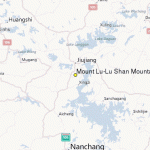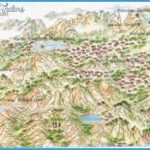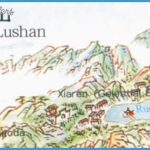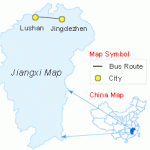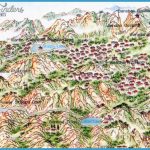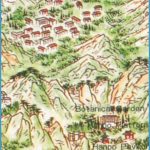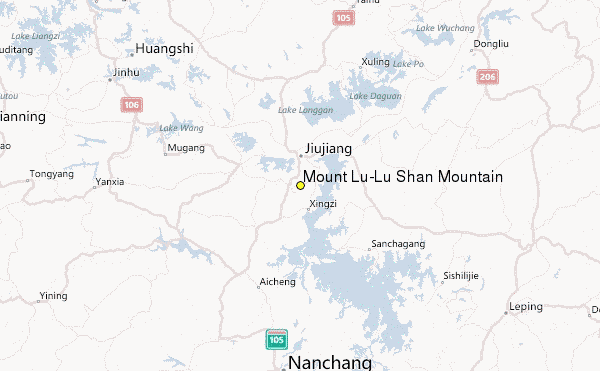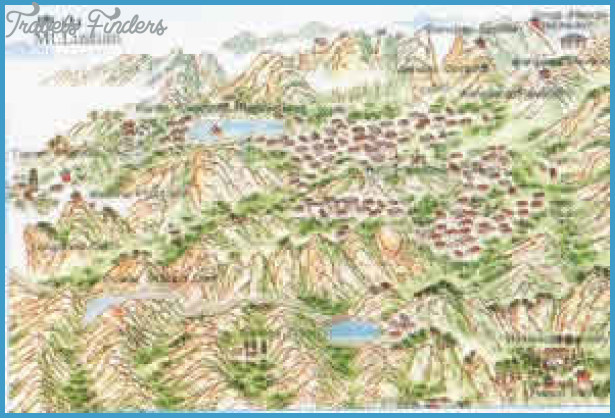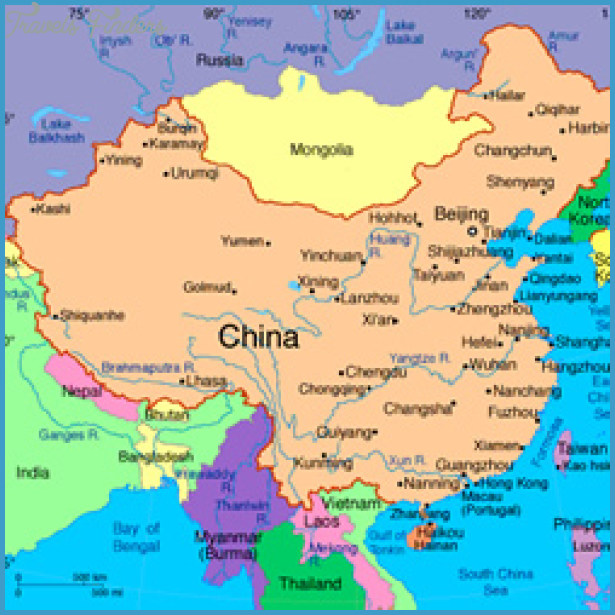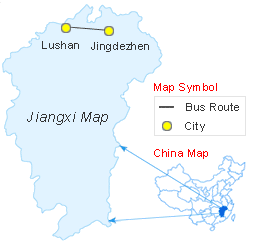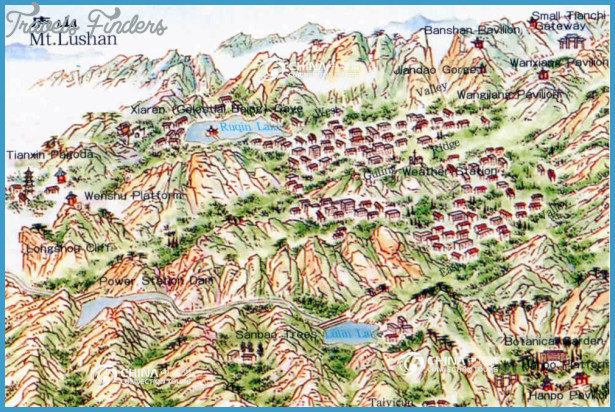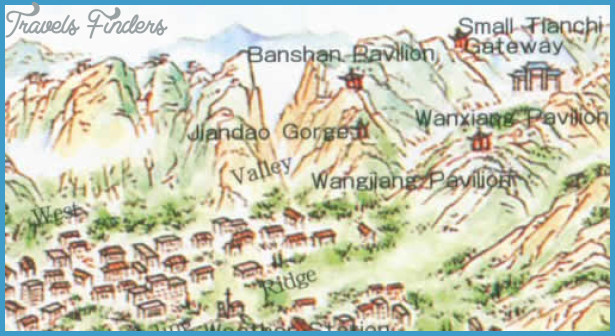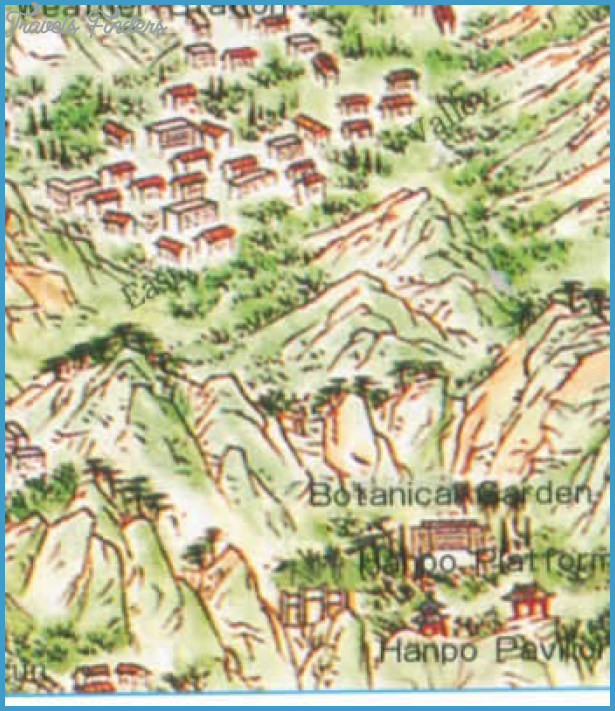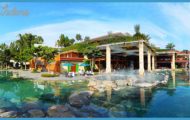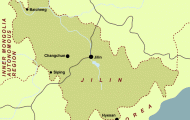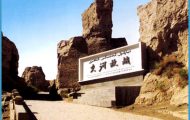To Lianhua (Lotus) Cave
Lake Gantang Hu in the city centre covers an area of 18ha/44 acres and receives its water from springs on Mount Lushan. The lake is divided by a 50m/164ft dam, on which is situated the Bridge ofthe Wise Men’s Longing (Sixian Qiao), dating from the Song period (960-1279).
The wave spring, which was formed in 201 b.c. is in the north ofthe city on the bank of the Changjiang. For many hundreds of years a very strange phenomenon could be observed: if a strong swell or wave built up in the river, the water in the spring would also ripple atthe same time. When the course of the Changjiang was diverted northwards, this phenomenon ceased to occur, although to this day the name of the spring serves as a reminder of it.
Surroundings
Mount Lushan Mount Lushan, which occupies an area of 250sq.km/97sq. miles, is one of the most popular recreational and holiday areas in China. It lies to the south of Jiujiang (bus connections), between Changjiang and Lake Poyang Hu. The massif comprises over 90 separate peaks, the highest, Hanyang Feng, having an altitude of 1474m/4836ft. Under the Han dynasty (206 b.c.-a.d.
Lushan developed into a Buddhist centre. Poets and writers in later centuries waxed lyrical about the irresistible charms of this mountain landscape. According to one such poet, Lushan has at least 2000 scenes of natural beauty with which to captivate the observer. The mountain also boasts intriguing rock formations, waterfalls, springs, pools, pavilions, temples and stone inscriptions.
The Temple of the East Wood on the north-west slopes of Mount Lushan is of extraordinary significance for Buddhists, as it was here that the monk Huiyuan (334-416) founded the School ofthe Pure Country (Jingtu Zong), a Buddhist sect. In 381 the monk had the temple built and lived in it for many years, interpreting and commenting on the teachings of Buddha.
The Pagoda of the West Wood, which rises up to the west of the temple, dates from the 8th c.
Guling is a spa situated in the middle ofthe Lushan massif at an altitude of 1167m/3829ft. Often referred to as the “Garden among the Clouds”, the resort has several modern hotels providing accommodation for visitors.
2km/1 mile to the south-west of Guling stands the Dragon Head Rock, from which there is a magnificent view across pine-woods, waterfalls, crisscrossing paths and highly unusual rock formations.
The Cave of the Immortal is practically 10m/33ft deep and lies to the north-west of Guling. According to legend, it was once the dwelling of the immortal Taoist monk Lu Dongbing (b. 798). The inscription atthe entrance to the cave dates from 1255.
The Floral Path, which lies to the east of the Cave of the Immortal, was celebrated by the poet Bai Juyi back in the Tang period (618-907). A stone tablet with the inscription “Floral Path”, which is said to have been engraved by Bai Juyi himself, is kept in the main pavilion.
The Pavilion ofthe Imperial Stele, not far in a north-westerly direction from the Cave of the Immortal, was built by the Ming Emperor Taizu in the 14th c. to commemorate a meeting with the immortal Taoist Zhou Dian. The inscription on the stele dates from the time of this emperor.
The Three Precious Trees, about 1km/1 mile south of Guling, are said to have been planted by the Buddhist monk Tan Xi 1500 years ago. They are described in the “Travel Sketches of Xu Xiake”, which date from the Ming period (1368-1644).
Hanpokou Hill, about 2km/1 mile south-east of Guling, is dominated by two pavilions, Hanpo Ting and Wangpo Ting. From the hill the visitor has a picturesque view of Lake Poyang Hu and the Changjiang.
The Summit of the Five Old Men in the south-east ofthe massif resembles, as its name suggests, the shape of five old men or five lotus blossoms.
The waterfall of Sandie Quan, which lies in the eastern part of the Lushan massif, forms a series of three cascades as it tumbles down into the valley below.
The School ofthe White Stag Cave, situated in the valley ofthe Wualo Feng, is one of the four most famous places of learning of the Song era (960-1279), in which the famous Confucian philosopher Zhu Xi (1130-1200) taught. Behind the school there is a cave with the stone sculpture of a white stag dating from the 16th c. It was fashioned to commemorate the brothers Li Bo and Li Shu, who sought refuge in the cave in 785 and spent their days there in the company of a white stag. the town’s dykes were opened as a defensive measure against invading Manchurians and as a result 300,000 people lost their lives. For this reason there are only very few architectural monuments surviving from the Song period. Today silk and embroidery provide an important source of income for Kaifeng. Sights In the old centre of Kaifeng a 400m/440yd long street with 36 buildings in the Song style has been reconstructed, with products and services charac-
Street in the teristic of the period on sale.
Song style yhe most interesting feature is the reproduction of the old Fan restaurant, mentioned in many old classical works. In one of these works the story is told of how the Song Emperor Huizong used to leave his palace in unobtrusive apparel and come to the restaurant, where he would spend many a merry evening in the company of thefamous actress Li Shishi, later to become his favourite concubine.
Between the streets of Beitu Jie and Nanjiaojing there are still traces of the old Jewish quarter, where from the 12th c. onwards the largest Jewish community in China lived.
Situation and Communications
The Temple of the Chancellor in.the city centre was built in 555 and for centuries was a renowned Buddhist centre. It was destroyed on several occasions – including the floods of 1644 – and then rebuilt, the last time in 1766. It was given its present name by a chancellor of the Tang era (618-907) who had made an outstanding contribution to restoration work on the building.
The most important building on the site is the Octagonal Ceramic Palace, the contents of which include a 7m/23ft high Guanyin statue. The gilded likeness of the goddess, with her four faces, 1000 arms and 1000 eyes, was created out of a single piece of Ginkgo wood. In the neighbouring bell-tower hangs an enormous 4m/13ft high bronze bell, weighing over 5 tons and dating from the Qing period (1644-1911).
The Dragon Pavilion, situated 1.5km/1 mileto the north ofthe Temple of the Chancellor in the Dragon Park, was built in 1692 on the site of a Ming palace which had been destroyed in the floods of 1644. The staircase leading to the pavilion is decorated with a dragon motif, while inside there is a stone bench, likewise ornamented with dragons.
The Iron Pagoda, which dates from 1049, is located in the north-east of the city, in the centre of the park of the same name. Owing to the rust-brown ceramic tiles with which it is covered, one could be forgiven for thinking it is made of iron – hence its name. The ascent to the top of the 55m/180ft high 13-storey pagoda is well worthwhile, rewarding the visitor with a beautiful view over Kaifeng and the surrounding area.
The terrace lies in a park of the same name in the south-east of the city, south of the railway line and 3km/2 miles from the Temple of the Chancellor. According to tradition the legendary Da Yu stayed here while he was subduing the Huanghe. On the terrace stands the Temple of King Yu (Yuwang Miao). To the south there is a wooden arch on which hangs a small plaque with the words “Ancient Terrace of the Musician”. Another legend has it that the famous musician Shi Kuang gave concerts here in the Spring and Autumn Periods (770-476 b.c.). For this reason the terrace is also known as the Music Terrace (Guchui Tai).
One of the halls is dedicated to famous poets of the Tang era (618-907) who composed verses here, such as Du Fu and Li Bai.
The hexagonal Pagoda Pota, formerly part of a temple from the Northern Song period (960-1127), is situated to the west of the Terrace of King Yu. It originally consisted of six storeys, of which only three survived the partial destruction ofthe building in the 14th c.

